Hollywood Royals: The Royal Ancestry of Humphrey Bogart
Last month, I wrote an article in which I proved that sisters Olivia de Havilland and Joan Fontaine are direct descendants of King Edward I of England and, therefore, kin to several prominent figures — not only several members of the British royal family, but also a number of U.S. presidents, authors and actors, including Humphrey Bogart. Now, he may not strike you as the aristocratic type, but Bogie also happened to be a direct descendant of Edward I, who was, in technical terms, his 19th great-grandfather.
If you remember, Edward I (1239-1307) married firstly Eleanor of Castile (1241-1290) in 1254. Their daughter, Elizabeth of Rhuddlan (1282-1316), was the wife of Humphrey de Bohun, 4th Earl of Hereford, 3rd of Essex (c. 1276-1321/2). So far, Bogie has the exact same ancestry as Joan and Olivia. But while the de Havilland sisters descended from Elizabeth and Humphrey's first daughter, Eleanor de Bohun, Bogie's blood line originated instead from their fifth son, Sir William de Bohun, 1st Earl of Northampton (c. 1312-1360).
In 1335, William married Elizabeth de Badlesmere (1313-1356), daughter of Bartholomew de Badlesmere, 1st Baron Badlesmere, and Margaret Clare, who were both strong opponents of King Edward II, William's uncle. In fact, Bartholomew was convicted of high treason and was subsequently hanged, drawn and quartered for having participated in a rebellion against Edward II, led by the king's first cousin, Thomas, 2nd Earl of Lancaster. As for Margaret, she was briefly imprisoned in the Tower of London for ordering an armed assault upon Isabella of France, Queen consort of Edward II, after which she retired to a convent.
In 1335, William married Elizabeth de Badlesmere (1313-1356), daughter of Bartholomew de Badlesmere, 1st Baron Badlesmere, and Margaret Clare, who were both strong opponents of King Edward II, William's uncle. In fact, Bartholomew was convicted of high treason and was subsequently hanged, drawn and quartered for having participated in a rebellion against Edward II, led by the king's first cousin, Thomas, 2nd Earl of Lancaster. As for Margaret, she was briefly imprisoned in the Tower of London for ordering an armed assault upon Isabella of France, Queen consort of Edward II, after which she retired to a convent.
 |
| LEFT: Portrait in Westminster Abbey, thought to be of Edward I. RIGHT: Tomb effigy of Eleanor of Castile at Westminster Abbey. |
William de Bohun and Elizabeth de Badlesmere had a son and a daughter; the girl, Elizabeth of Bohun (c. 1350-1385), married military commander Richard FitzAlan, 11th Earl of Arundel (1346-1397), 2nd great-grandson of King Henry III of England. FitzAllan strongly opposed King Richard II's desire for peace with France in the Hundred Years War. In 1397, he was arrested for his opposition to the monarch and for plotting to imprison him, and was sentenced to death by beheading. Ironically, at Richard II's coronation on 1377, FitzAlan had carried the crown.
Richard FitzAlan and Elizabeth of Bohun were parents to seven children, including Joan FitzAlan, 14th great-grandmother of Joan Fontaine and Olivia de Havilland. Their other daughter, Elizabeth FitzAlan (c. 1366-1425), married thirdly Sir Robert Goushill of Hoveringham (c. 1362-1403), who gave her two daughters. The youngest, Joan Goushill (c. 1401-c. 1466), became the wife of Thomas Stanley, 1st Baron Stanley, King of Mann (c. 1405-1459), a Member of Parliament who represented Lanchashire in the House of Commons in several instances between 1427 and 1455. By Thomas, Joan was mother to Margaret Stanley (1436-1481), who married Sir John Boteler, Baron of Warrington (1429-1463) around January 1459 or 1460.
Richard FitzAlan and Elizabeth of Bohun were parents to seven children, including Joan FitzAlan, 14th great-grandmother of Joan Fontaine and Olivia de Havilland. Their other daughter, Elizabeth FitzAlan (c. 1366-1425), married thirdly Sir Robert Goushill of Hoveringham (c. 1362-1403), who gave her two daughters. The youngest, Joan Goushill (c. 1401-c. 1466), became the wife of Thomas Stanley, 1st Baron Stanley, King of Mann (c. 1405-1459), a Member of Parliament who represented Lanchashire in the House of Commons in several instances between 1427 and 1455. By Thomas, Joan was mother to Margaret Stanley (1436-1481), who married Sir John Boteler, Baron of Warrington (1429-1463) around January 1459 or 1460.
Margaret Stanley and John Boteler were parents to three children, the eldest being a son named Sir Thomas Boteler (c. 1462-1522), who became seneschal of Liverpool. He married Margaret Delves (c. 1465-1532), daughter of Sir John Delves, Sheriff of Stafford, who was beheaded by Yorkist supporters at the Battle of Tewkesbury for being a Lancastrian. The Houses of Lancaster and York fought for over thirty years for control of the throne of England, in a series of conflicts that became known as the Wars of the Roses. The Lancastrian branch, descended from John of Gaunt, great-grandson of Edward I, eventually triumphed, leading to the establishment and accession of the Tudor dynasty, which began with King Henry VII.
Thomas Boteler and Margaret Delves had one son and eight daughters. One of the girls, Margery Boteler (b. 1503), married Sir Thomas Southworth (c. 1497-1546), also a descendant of Edward I via his paternal great-grandmother, Anne Tuchet. Through her mother, Margaret de Ros, Anne was a direct descendant of Sir Robert de Ros, a Magna Carta Surety. Anne's grandfather, William de Ros, 2nd Baron de Ros of Hemsley, had married Elizabeth Badlesmere's sister, Margery. William and Margery were the maternal grandparents of Anne Welles, 14th great-grandmother of Joan Fontaine and Olivia de Havilland. Because they had Bartholomew Badlesmere as a common ancestor, Margery Boteler was a 7th cousin to her husband.
Thomas Boteler and Margaret Delves had one son and eight daughters. One of the girls, Margery Boteler (b. 1503), married Sir Thomas Southworth (c. 1497-1546), also a descendant of Edward I via his paternal great-grandmother, Anne Tuchet. Through her mother, Margaret de Ros, Anne was a direct descendant of Sir Robert de Ros, a Magna Carta Surety. Anne's grandfather, William de Ros, 2nd Baron de Ros of Hemsley, had married Elizabeth Badlesmere's sister, Margery. William and Margery were the maternal grandparents of Anne Welles, 14th great-grandmother of Joan Fontaine and Olivia de Havilland. Because they had Bartholomew Badlesmere as a common ancestor, Margery Boteler was a 7th cousin to her husband.
 |
| LEFT: 15th-century depiction of the Battle of Tewkesbury. RIGHT: King John of England reluctantly signing the Magna Carta (illustration by Arthur C. Michael, early 20th century). |
Edward Southworth and Alice Carpenter had two sons, both of whom were born in Leiden. After noticing that their children were losing their English background and becoming Dutch, members of the Separatist Movement in Leiden, including Edward and Alice, returned to England with their families. Upon the death of her husband, Alice sailed to America at the invitation of William Bradford, a fellow English Separatist who had courted her in Leiden before she married Edward. She had reciprocated William's affections, but her strict father was opposed to their marriage.
Alice landed at Plymouth Colony in June 1623 and married William within two months. He had arrived at the Colony on the Mayflower in 1620 with his wife Dorothy, but she accidentally fell overboard and drowned when the ship anchored in what is now Provincetown Harbor, Massachusetts. In 1621, William was elected Governor of Plymouth, a position which he retained for most of the rest of his life. Alice's two young sons from her first marriage, whom she had left in England for schooling, joined their mother in the Colony in 1628 and were brought up in the home of Governor Bradford. Her son Thomas Southworth (c. 1616/7-1669) went on to occupy important positions, including military captain, assistant Governor to both his stepfather and Thomas Prence, as well as commissioner to the New England Confederacy.
Alice landed at Plymouth Colony in June 1623 and married William within two months. He had arrived at the Colony on the Mayflower in 1620 with his wife Dorothy, but she accidentally fell overboard and drowned when the ship anchored in what is now Provincetown Harbor, Massachusetts. In 1621, William was elected Governor of Plymouth, a position which he retained for most of the rest of his life. Alice's two young sons from her first marriage, whom she had left in England for schooling, joined their mother in the Colony in 1628 and were brought up in the home of Governor Bradford. Her son Thomas Southworth (c. 1616/7-1669) went on to occupy important positions, including military captain, assistant Governor to both his stepfather and Thomas Prence, as well as commissioner to the New England Confederacy.
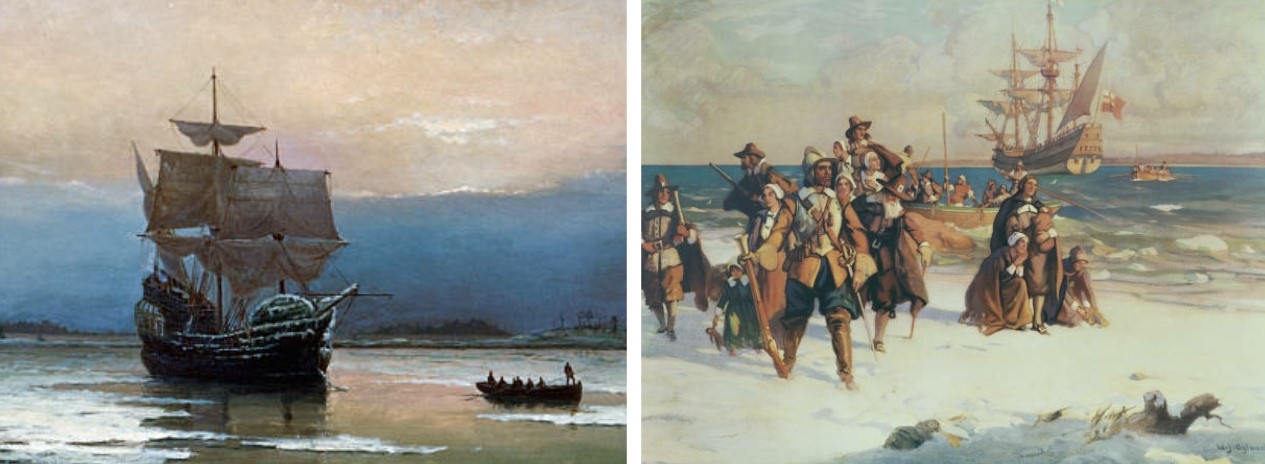 |
| LEFT: The Mayflower in Plymouth Harbor (painting by William Halsall, 1882). RIGHT: The Pilgrim Fathers arriving at Plymouth Colony on board the Mayflower (painting by William James Aylward). |
By Thomas, Elizabeth became mother to Elizabeth Southworth (c. 1644-1717), who married Joseph Howland (c. 1640-1703/4) on December 7, 1664. Joseph was the seventh of ten children of John Howland and Elizabeth Tilley, who had both sailed to the New World on the Mayflower. Elizabeth's parents, John Tilley and Joan Hurst, were also Mayflower passengers, but they both died during their first winter in Plymouth due to the harsh weather conditions, along with 45 other passengers.
Lydia and Joseph were parents to seven daughters and two sons; their second youngest girl, Prudence Jenkins (1718-1793), married Deacon Samuel Baker (1706-1791) in Barnstable, on May 30, 1732. Samuel's 2nd great-grandfather, Reverend John Robinson, had been pastor of the English Separatists in Leiden before they left on the Mayflower. In fact, Rev. Robinson is credited with having organized the historical Mayflower voyage, as he believed that the New World could provide a way for his congregation members to remain loyal to their King, but still follow whatever religion they pleased. He planned to sail to America with the rest of the congregation at a later date, but he became ill and died in Leiden before that could happen.
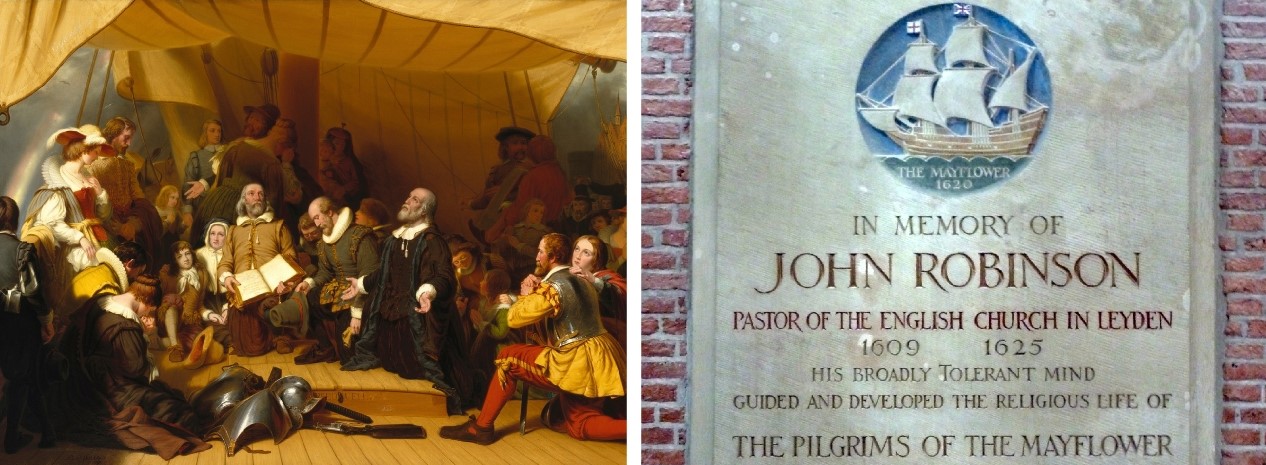 |
| LEFT: Embarkation of the Pilgrims (painting by Robert Walter Weir, 1857). RIGHT: Plaque commemorating Rev. John Robinson, in Pieterskerk, Leiden. |
Prudence Jenkins and Samuel Baker had one son and four daughters, including Bethiah Baker (1737-1820), who married John Perkins Jr. (1736/7-1800) on April 14, 1760. John's 2nd great-grandfather, John Perkins, had sailed from Bristol, England to Boston, Massachusetts in December 1630, taking with him his wife, Judith Gater, and five children.
By John, Bethiah was mother to two sons and one daughter. The eldest boy, Dyer Perkins (1753-1818), became the husband of Charlotte Sophia Woodbridge (1787-1851), whose 4th paternal great-grandfather, Thomas Dudley, had arrived in the New World in 1630. He served four one-year terms as Governor of the Massachusetts Bay Colony and help found Harvard College in 1636. Thomas Dudley was a direct descendant of Sir Walter Blount, a soldier who was mistaken for the Lancastrian King, Henry IV, at the Battle of Shrewsbury and killed in his place by the opposing rebel forces led by Henry «Harry Hotspur» Percy. Through a separate blood line, Sir Walter Blount was also a direct ancestor of Joan Fontaine and Olivia de Havilland.
By John, Bethiah was mother to two sons and one daughter. The eldest boy, Dyer Perkins (1753-1818), became the husband of Charlotte Sophia Woodbridge (1787-1851), whose 4th paternal great-grandfather, Thomas Dudley, had arrived in the New World in 1630. He served four one-year terms as Governor of the Massachusetts Bay Colony and help found Harvard College in 1636. Thomas Dudley was a direct descendant of Sir Walter Blount, a soldier who was mistaken for the Lancastrian King, Henry IV, at the Battle of Shrewsbury and killed in his place by the opposing rebel forces led by Henry «Harry Hotspur» Percy. Through a separate blood line, Sir Walter Blount was also a direct ancestor of Joan Fontaine and Olivia de Havilland.
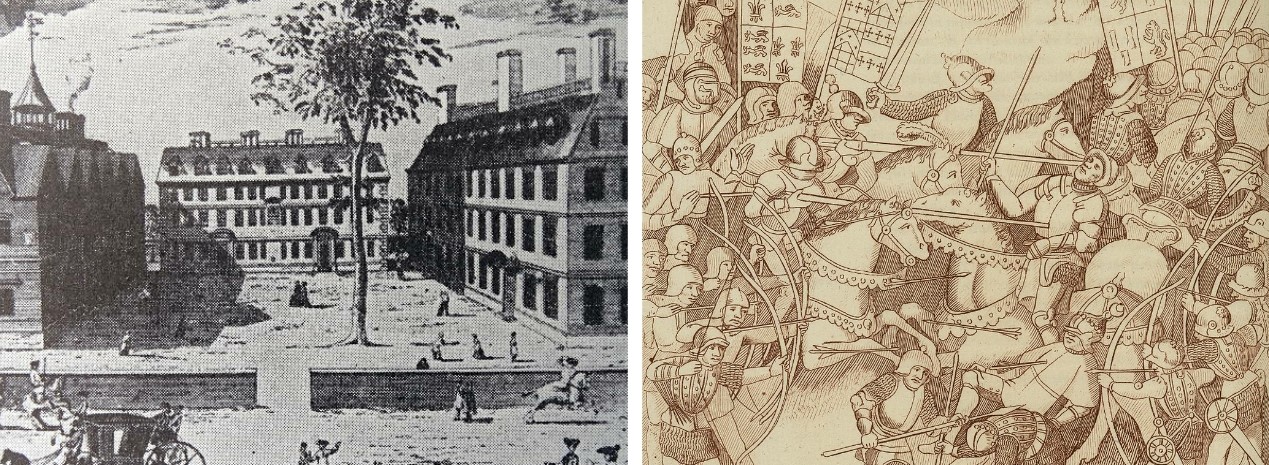 |
| LEFT: Engraving of Harvard College (1638). RIGHT: Illustration of the Battle of Shrewsbury from A Tour in Wales by Thomas Pennant (1781). |
Dyer and Charlotte had a daughter named Elizabeth Rogers Perkins (b. 1808), who married Harvey Humphrey (1796-1877) in Rochester, New York, on October 2, 1828. Harvey's grandfather, Isaac Humphrey, had acted as a dispatch bearer for General Philip Schuyler, commander of the Northern Department, during the American Revolutionary War. In turn, Isaac's 2nd great-grandfather, Matthew Grant, had arrived from England in Dorchester, Massachusetts in 1630 with his wife and daughter, both named Priscilla.
Elizabeth and Harvey's son, John Perkins Humphrey (1836-1891), married Frances Churchill (1837-1897) in Rochester on January 12, 1864. Her 3rd great-grandfather, Samuel Curtis, had emigrated to America from Sheffield, England in 1690. John and Frances were parents to Maud Humphrey (1868-1940), who revealed a great talent for drawing at a very young age. After studying at the Arts Student League of New York and at the Julian Academy in Paris, she became a sought-after illustrator for calendars, magazines, children's books and advertisements for such famous companies as Ivory Soap and Mellin's Baby Food. Later on, she was offered a position as art director of The Delineator, a prominent ladies' magazine.
Elizabeth and Harvey's son, John Perkins Humphrey (1836-1891), married Frances Churchill (1837-1897) in Rochester on January 12, 1864. Her 3rd great-grandfather, Samuel Curtis, had emigrated to America from Sheffield, England in 1690. John and Frances were parents to Maud Humphrey (1868-1940), who revealed a great talent for drawing at a very young age. After studying at the Arts Student League of New York and at the Julian Academy in Paris, she became a sought-after illustrator for calendars, magazines, children's books and advertisements for such famous companies as Ivory Soap and Mellin's Baby Food. Later on, she was offered a position as art director of The Delineator, a prominent ladies' magazine.
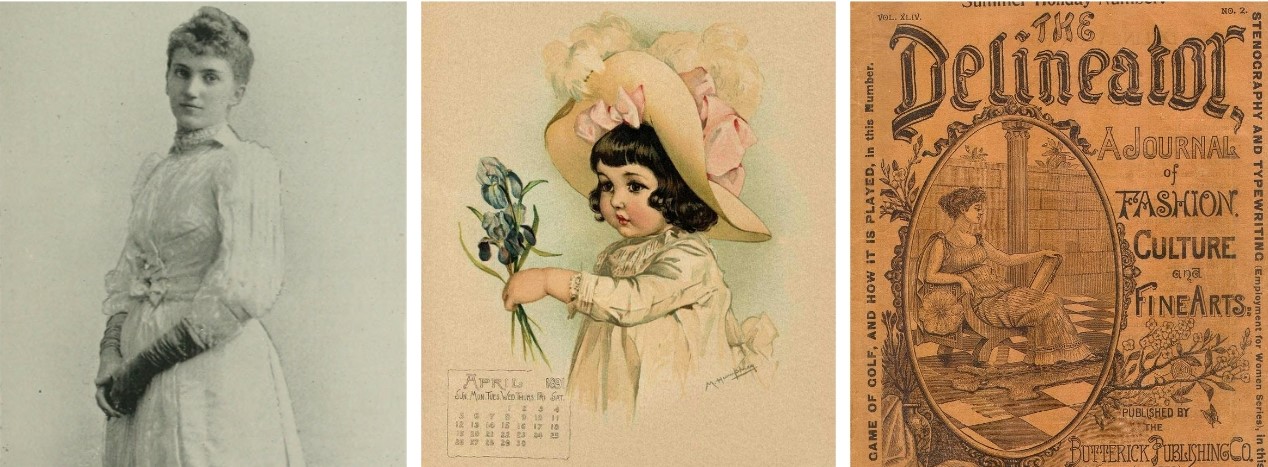 |
| LEFT: Maud Humphrey c. 1893-1897. MIDDLE: One of Maud's illustrations from a 1891 wall calendar. RIGHT: August 1894 cover of The Delineator. |
After Julia died, Adam concentrated all of his energy and ambition on his only surviving son, Belmont, who went on to serve on the staff of three prominent Manhattan hospitals — all by the time he was 30 years old. When he and Maud first met, Belmont was drawing a yearly salary of $20,000, an excellent sum in those days. Maud, however, was already earning twice as much.
«There was a period in American history when you couldn't pick up a God damn magazine without seeing my cute little kisser in it.»
Little Humphrey, of course, would grow up to become one of the most iconic and respected actors of the Classic Hollywood era, with a stellar film career that spanned nearly three decades.
Making his debut in the two-reeler The Dancing Town (1928), Bogie found himself typecast as a gangster in a series of second-rate crime dramas throughout the 1930s. He finally became a star playing the lead role his good friend John Huston's The Maltese Falcon (1941), but it was his Academy Award-nominated performance in Casablanca (1942) that truly redefined his career. By 1946, he had become the highest-paid actor in the world. He won the Oscar for Best Actor for playing a rough-and-tumble boat captain in Huston's The African Queen (1951), receiving a third and final nomination for his portrayal of the mentally unstable Captain Queeg in The Caine Mutiny (1954). A longtime heavy smoker and drinker, Bogart developed cancer of the esophagus, which eventually took his life on January 13, 1957. At his funeral, it was Huston who delivered the eulogy, reminding the mourners that «there will never be another like him.»
Plymouth Colony, Its History and People, 1620-1691 by Eugene Aubrey Stratton (Ancestry Publishing, 1986)
 |
| LEFT: Maud Humphrey and baby Bogie. MIDDLE: Bogie at 10 months. RIGHT: Bogie c. 1901. |
Making his debut in the two-reeler The Dancing Town (1928), Bogie found himself typecast as a gangster in a series of second-rate crime dramas throughout the 1930s. He finally became a star playing the lead role his good friend John Huston's The Maltese Falcon (1941), but it was his Academy Award-nominated performance in Casablanca (1942) that truly redefined his career. By 1946, he had become the highest-paid actor in the world. He won the Oscar for Best Actor for playing a rough-and-tumble boat captain in Huston's The African Queen (1951), receiving a third and final nomination for his portrayal of the mentally unstable Captain Queeg in The Caine Mutiny (1954). A longtime heavy smoker and drinker, Bogart developed cancer of the esophagus, which eventually took his life on January 13, 1957. At his funeral, it was Huston who delivered the eulogy, reminding the mourners that «there will never be another like him.»
______________________________________________
SOURCES: Plymouth Colony, Its History and People, 1620-1691 by Eugene Aubrey Stratton (Ancestry Publishing, 1986)
The Secret Life of Humphrey Bogart: The Early Years (1899-1931) by Darwin Porter (The Georgia Literary Association, 2003)
Tough Without a Gun: The Extraordinary Life of Humphrey Bogart by Stefan Kanfer (Vintage Books, 2011)

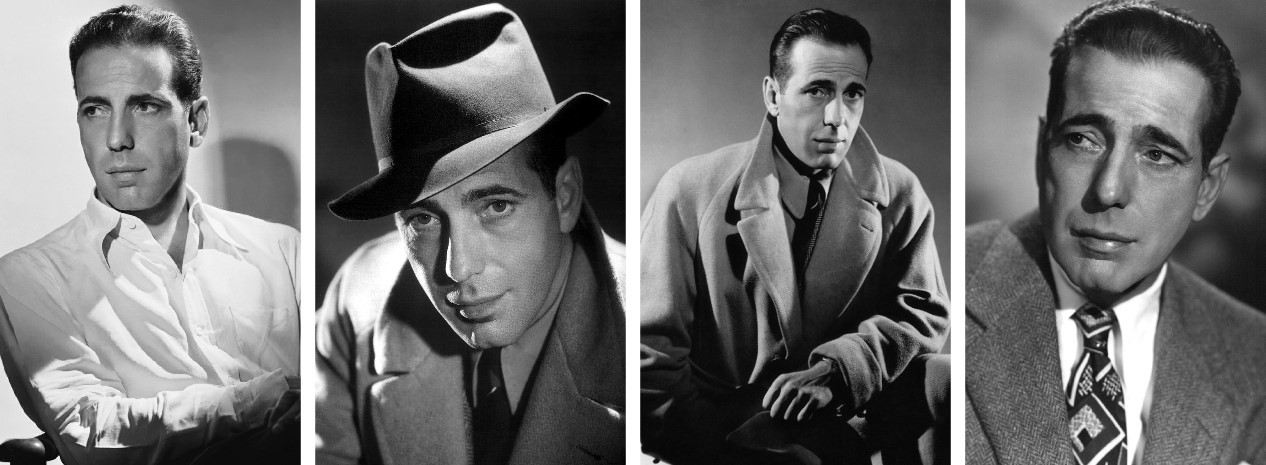







This is so cool!!! Impressive post!! Happy New Year! :)
ReplyDeleteThank you. Happy New Year to you too. :)
Delete